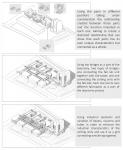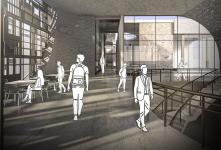Recycling Center Integrated with fab labs located in South Marka, Jordan.
The expansion and development of complex infrastructures, have spatially separated the environment of consumption from the resource bases that sustain it. The exponential exhaustion of natural resources, declining productivity leading to air, land and water pollution forces us to rethink our economic models. Where do we go from here? The automotive industry is probably the largest business in the world and considered to be the major source of consumer spending, making it the primary source for solid waste around the world and when a car is no longer useful as a means of transportation it will get disposed in junkyard.
In the middle of North Marka, a town located in Amman, Jordan, we find a gap (scrap yard) that torn the city and divides the urban context of it where residential neighborhoods sprawl around it, making it an inconvenient spot for the residents of Marka and a source of hazards, pollution, noise, and unethical behavior. Marka location as connection between Zarqa and Center of Amman act as important point in addressing this project as a beginning of change. Marka hosting one of the biggest scrap yards in Jordan with an area 2,009,763.4. still expanding on the interest of the residential areas around it.
“Pollution is nothing but the resources we are not harvesting. We allow them to disperse because we've been ignorant of their value”
Design Intentions:
1. The need for a cultural shift.
This project aims to challenge people’s current thinking, raising awareness that the issue of sustainability will not be resolved without a significant cultural shift in our relationship with our world’s environmental systems. The thesis addresses this through an architectural narrative conceived to enhance the viewer’s awareness of how our interdependent relationship with machines and industry has led to this dire situation. Prior to the Industrial Revolution the environment could regenerate and recover faster than humanity could destroy it. With the advent of the Industrial Revolution this changed and environmental degradation has rapidly increased out of control.
2. Satisfying the needs of Marka.
This project came as an opportunity to satisfy the needs of Marka, it seeks to explore how industrial cities could spark social and economic growth. Marka is a live example of how can we face poverty, unemployment, dysfunction in population distribution and lack of education by turning the problem it has into resources towards growth.
3. Introduce new approach in architecture. “Scrap as a building material”
The answer lies in the concept of Junk Architecture, one of the recent efforts to save the environment while being economically beneficial. The recycling of buildings is a healthy green practice, stressing the importance of sustainability. This is an invention of triple impact- economic, environmental, and social.
2022
- Architecture Identity: The building itself, material used in the building and the construction method. - Innovation and production: The program, function, the process and eventually the added value to site, city and eventually Jordan as a whole.
The program is divided into three main zones: 1- the production part which is a factory includes inspection, disassembly sorting, press and storage. 2- the innovation part which is the fab lab “to innovate a new product using the material from scrap 3- the administration.
Fab labs and makerspaces are drivers of multidisciplinary, as they often combine people from different backgrounds. As such, they enable both engineering/STEM students to acquire business and entrepreneurship skills and business students and entrepreneurs to acquire technological skills.
the plot size of the project is 12300 sqm, minimum built percentage of 51% and the total built area is 5200 sqm.
Designer: Sondos Barhumi
Supervisor: Dr.Nancy Al-Assaf








